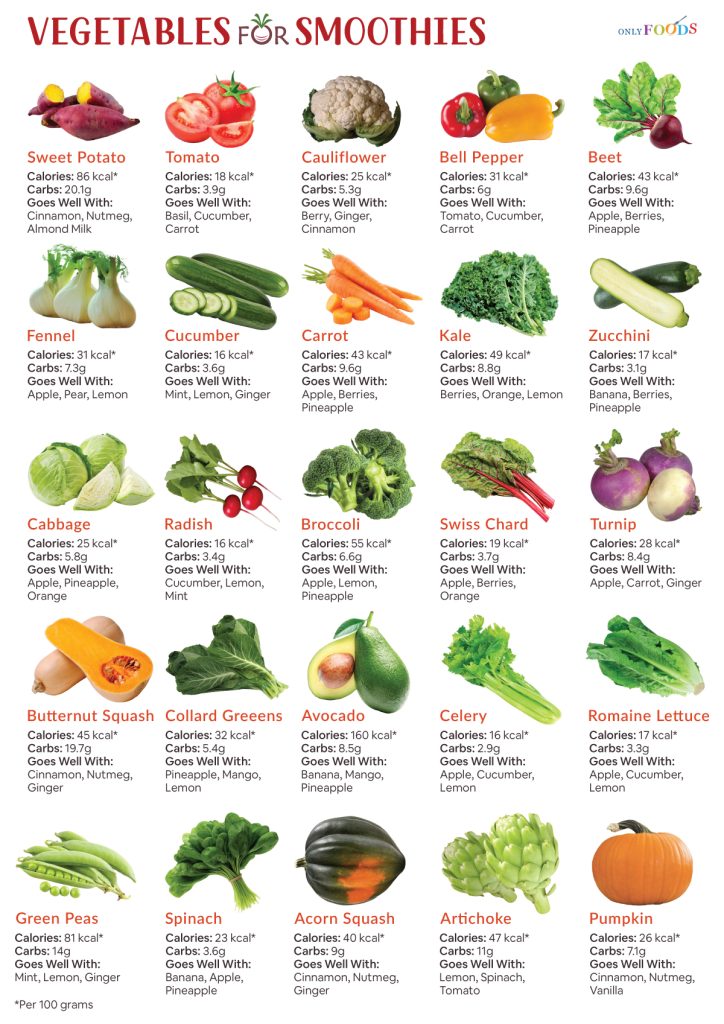Best Vegetables for Making Smoothies
It is pretty standard to have a smoothie for breakfast – they’re fast, healthy, delicious, and easy to digest. Fruits are a more natural choice for making smoothies, but vegetables can be an even better option. Vegetable smoothies are low in sugars but rich in fiber, vitamins, and minerals.
When making such a smoothie, the goal is often to get more vegetables into your diet while keeping things from getting boring. To that end, the smoothie’s taste matters almost as much as its nutritional value.
List of Vegetables Good to Put in Smoothies
The table below lists 25 vegetables most commonly added to healthy smoothies and an idea for combining them with other ingredients. Vegetables with a mild flavor are easier to hide in a smoothie when mixed with sweet, strong-flavored fruits and other ingredients. These include spinach (especially baby spinach), cucumber, zucchini, cabbage, and cauliflower.
Note that experts suggest smoothies can be as healthy as eating whole vegetables. Because, unlike juicing, blending can keep vegetables’ nutrients intact. You can blend its flesh, seeds, and skin, and the blender does not remove any part of it. So, the carbs and calories in a smoothie will be the same as in the whole vegetable.
| Name | Carbs per 100g | Calories per 100g | Taste & Flavor | Goes Well With |
|---|---|---|---|---|
| Spinach | 3.6g | 23 kcal | Mild, earthy, slightly bitter | Banana, Apple, Pineapple |
| Kale | 8.8g | 49 kcal | Slightly bitter, robust | Berries, Orange, Lemon |
| Carrot | 9.6g | 41 kcal | Sweet, slightly earthy | Apple, Ginger, Orange |
| Beet | 9.6g | 43 kcal | Earthy, sweet | Apple, Berries, Pineapple |
| Zucchini | 3.1g | 17 kcal | Mild, slightly sweet, neutral | Banana, Berries, Pineapple |
| Avocado | 8.5g | 160 kcal | Creamy, rich, nutty | Banana, Mango, Pineapple |
| Sweet Potato | 20.1g | 86 kcal | Sweet, starchy | Cinnamon, Nutmeg, Almond Milk |
| Cucumber | 3.6g | 16 kcal | Refreshing, slightly sweet | Mint, Lemon, Ginger |
| Pumpkin | 7.1g | 26 kcal | Mild, slightly sweet, nutty | Cinnamon, Nutmeg, Vanilla |
| Broccoli | 6.6g | 55 kcal | Earthy, slightly bitter | Apple, Lemon, Pineapple |
| Cauliflower | 5.3g | 25 kcal | Mild, slightly nutty | Berry, Ginger, Cinnamon |
| Cabbage | 5.8g | 25 kcal | Mild, slightly peppery | Apple, Pineapple, Orange |
| Swiss Chard | 3.7g | 19 kcal | Earthy, slightly bitter | Apple, Berries, Orange |
| Collard Greens | 5.4g | 32 kcal | Mild, slightly bitter, robust | Pineapple, Mango, Lemon |
| Romaine Lettuce | 3.3g | 17 kcal | Mild, slightly bitter | Apple, Cucumber, Lemon |
| Celery | 2.9g | 16 kcal | Crisp, slightly salty, mild | Apple, Cucumber, Lemon |
| Bell Pepper | 6g | 31 kcal | Sweet, slightly tangy, crisp | Tomato, Cucumber, Carrot |
| Butternut Squash | 19.7g | 45 kcal | Sweet, nutty | Cinnamon, Nutmeg, Ginger |
| Acorn Squash | 9g | 40 kcal | Sweet, nutty | Cinnamon, Nutmeg, Ginger |
| Tomato | 3.9g | 18 kcal | Sweet, tangy | Basil, Cucumber, Carrot |
| Green Peas | 14g | 81 kcal | Sweet, slightly starchy | Mint, Lemon, Ginger |
| Turnip | 8.4g | 28 kcal | Peppery, slightly bitter | Apple, Carrot, Ginger |
| Artichoke | 11g | 47 kcal | Earthy, slightly nutty | Lemon, Spinach, Tomato |
| Fennel | 7.3g | 31 kcal | Slightly sweet, licorice-like | Apple, Pear, Lemon |
| Radish | 3.4g | 16 kcal | Peppery, crisp | Cucumber, Lemon, Mint |
Cruciferous and root vegetables like cauliflower, broccoli, beet, carrot, and sweet potato have a more rigid texture and can be gently steamed and cooled before adding them to the blender. It helps mask their taste while giving a thick texture to the smoothie. Vegetables like celeriac, kohlrabi, and jicama can also be used similarly.
FAQ
Frozen vegetables work as well as fresh ones. Some, like cauliflower, zucchini, and broccoli, are better to be used frozen as they render an even creamier texture to the smoothie.
You can freeze seasonal vegetables to use later or use pre-frozen vegetables available at stores.

